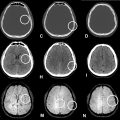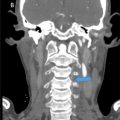Abstract
The Sister Mary Joseph nodule is a rare sign of advanced malignancy, including uterine carcinosarcoma. A 55-year-old woman presented with a necrotic, bleeding 4 cm umbilical mass. Biopsy confirmed uterine carcinosarcoma (FIGO stage IVB), and she was scheduled for chemotherapy and radiotherapy. This case underscores the need to recognize umbilical nodules as potential markers of widespread cancer.
Introduction
The Sister Mary Joseph nodule, or sign, is a rare but significant physical finding indicating advanced malignancy, manifesting as a palpable nodule in the umbilicus due to cancer metastasis [ ]. One potential cause is uterine carcinosarcoma, also known as malignant mixed Müllerian tumor (MMMT), a highly aggressive and often fatal biphasic neoplasm with carcinomatous and sarcomatous components. It accounts for about 2%-3% of all uterine cancers. MMMTs can metastasize via lymphatic channels and hematogenous routes to the pleura, lungs, liver, and lymph nodes. Cutaneous metastases are extremely rare, occurring in only 0.8% of patients with uterine cancer [ ].
This report presents a case of malignant mixed Müllerian tumor manifested through a Sister Mary Joseph’s nodule.
Case report
We reported, in accordance with SCARE guidelines [ ], a case report of a 55-year-old woman, presented to our emergency department with a protruding umbilical mass that had appeared 2 months earlier. The working diagnosis was a Sister Mary Joseph nodule with underlying gynecological malignancy. She is a nulligravida, claims to be a virgin, and has been menopausal for 5 years. She had no personal or family history of gynecological or breast cancer. On clinical examination, she had a 4 cm umbilical mass that was protruding, necrotic, and bleeding on contact ( Fig. 1 ).

The patient was referred to our department for further evaluation and management. On clinical examination the patient was afebrile, pale, and asthenic, with a prominent umbilical lesion measuring 5 × 4 cm. The lesion’s characteristics, combined with the patient’s general condition, raised concerns about a possible malignant etiology. Differential diagnoses considered included primary malignancy of the umbilicus, such as adenocarcinoma, metastatic disease (Sister Mary Joseph’s nodule) secondary to intra-abdominal or pelvic cancers, or an infectious or inflammatory process such as an umbilical abscess. These possibilities necessitated a comprehensive diagnostic approach, including biopsy of the lesion, imaging studies, and laboratory tests, to establish the underlying pathology and guide subsequent management.
A biopsy of the lesion was performed. Laboratory tests indicated severe hypochromic microcytic anemia secondary to iron deficiency, with a hemoglobin level of 5 g/dL. Pelvic ultrasonography demonstrated an enlarged uterus measuring 12 × 7 cm, with an indistinct endometrial outline and nonvisualized adnexa. Computed tomography (CT) revealed a pelvic tissue mass measuring 93 × 80 × 90 mm, accompanied by secondary involvement of the cutaneous umbilical region, peritoneal carcinomatosis nodules, and a large umbilical hernia.
Magnetic resonance imaging (MRI) depicted a large pedunculated tissue mass on the anterior cervical wall, measuring 95 × 80 mm. The skin biopsy reveals a proliferation of atypical tumor cells with both epithelial and mesenchymal characteristics, suggesting a biphasic nature of the tumor ( Fig. 2 ).











